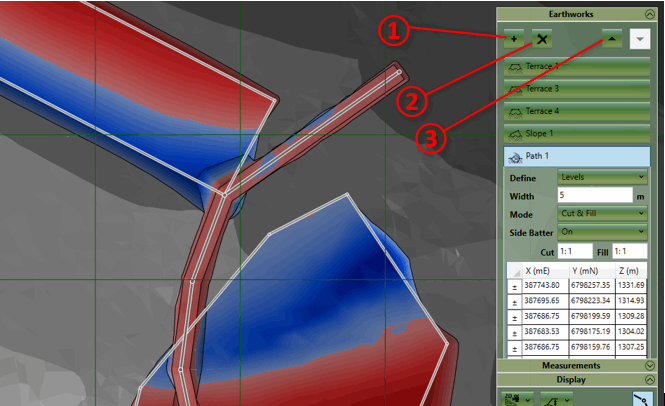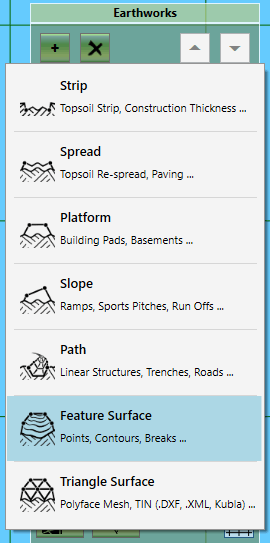Each phase in a project contains an earthworks panel. This is where earthworks elements such as platforms, slopes, paths and feature surfaces can be added to the project. The earthworks elements in a panel are combined together to create a single proposed surface within a single phase.

Adding Elements
New elements can be added to the earthworks panel by clicking on the + symbol ①. You will be presented with the following list of elements that you can add :

-
Strip
The strip element removes a specified thickness of material from a specified area of the site. This is very commonly used for stripping topsoil from the existing ground. For more information see Strip Element .
-
Spread
The spread element adds a specified thickness of material to a specified area of the site. This is most commonly used for paving. For more information see Spread Element .
-
Platform
The platform element adds a specified area with a specified elevation to the site. I.e. a flat area. This is most commonly used for defining building pads and retention ponds. For more information see Platform Element .
-
Slope
The slope element adds a specified area with a specified slope to the site. This is most commonly used for access ramps and run-offs. For more information see Slope Element .
-
Path
The path element adds a path of a specified width with a specified centreline to the site. This is most commonly used for access roads and trenches. For more information see Path Element .
-
Feature Surface
The feature surface element adds a surface defined with elevation 'features' (outlines, contours, break-lines and points). This is most commonly used for take-offs such as those required by contractors for bidding purposes. For more information see Feature Surface Element .
-
Triangle Surface
The triangle surface element is used to define a surface using a triangulation imported from another file. This is most commonly used to import data from other programs which support triangulations (TINS). For more information see Triangle Surface Element .
When you have selected an element you will be able to start drawing its boundary or centreline points in the design area. Left click to place a new point, right click or press Enter to complete the creation of the element. If you want to cancel the operation entirely hit Esc key. When adding new elements the back space key can be used to undo the last placed point if a mistake has been made.
Renaming Elements
After an element is created it is a good idea to give it a relevant name so it can be identified in the report (e.g building pad 1 or car park). To do this just double click on the name of the element and then overtype.
Editing Elements
Selection : Elements can be selected by left clicking on the title bar in the earthworks panel or by left clicking on there boundary or centre lines in the design area. Multiple elements can be selected by holding down Ctrl whilst making the selection. To unselect an element you can right click on it.
Edit Mode : If you double click on an element it will enter into 'edit mode', the properties of the element will be exposed and you will be able to edit the definition points of the element in the design view. To exit 'edit mode' double left click in empty space in the design view.
Definition Points : When an element is in 'edit mode' the definition points of the boundary or centreline can be changed. In the design view left click on a point and drag it to the desired position. A point can be deleted by using the Delete key. New points can be inserted by selecting a line and hitting the Z key. Points can also by edited directly in the point list in the element properties. Clicking on the top right corner of the point list allows all the points to be copied using the menu command or Ctrl+C. Likewise a list of points can also be pasted into the point list from another program by clicking on the top right corner and using menu paste command or Ctrl+V.
Properties: For information on the individual element properties refer to the relevant sections for each element.
Notes on Point Snapping : When creating or editing the definition points of a earthworks element it is possible to snap the points to other element definition points or to defined grid positions. To access the point snapping options click on the Edit menu and then the Snap Points. Here you can toggle snapping to boundary points and grid points as well as setting the interval and origin point of the grid used for snapping.
Amending the Calculation Order
You can amend the order of elements in the list by selecting an element and using the up down buttons ③. The order of earthworks becomes critically important when two or more earthworks intersect. The calculation order can change the way that the proposed surface is built and thus change the cut & fill estimate of a project. For more information refer to the calculation order section of the user guide.
Copying & Pasting
It is often useful to copy and paste elements, this can be done using Edit menu commands or the keyboard shortcuts (Ctrl+C, Ctrl+V). You can copy and paste in the same phase to duplicate an element or copy and paste to move elements to different phases.
Deleting Elements
Elements can be deleting by first selecting them and then clicking on the X button at the top of the panel ②.